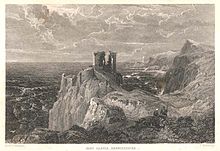
Quick Facts

Biography
Sir Robert Logan of Restalrig (c.1555-July 1606) was a Scottish knight involved in the Gowrie House affair of 1600.
Family
Robert's father was also called "Robert Logan of Restalrig," his mother was Agnes Gray, daughter of Patrick Gray, 4th Lord Gray. In 1547, his father, Robert Logan of Restalrig was married to Agnes Seton. During the crisis of the Scottish reformation in 1559, this Robert Logan senior took his Leith followers to face the French troops of Henri Cleutin at Cupar Muir. Later he advised against resistance at Leith by the Protestant Lords of the Congregation against the French troops of Mary of Guise, which led to a short-lived truce by the terms of the articles of Leith.
After Robert Logan senior died, his widow Agnes Gray married Alexander Home, 5th Lord Home. Robert the heir firstly married Elizabeth Makgill, daughter of David Makgill of Cranston-Riddell, then Jonet Ker and thirdly Marion Ker. Robert's first wife, Elizabeth Makgill, after their divorce, married Sir Thomas Kennedy of Culzean, Tutor of Cassilis.
Properties

The Logan family lived at Lochend Castle near Restalrig, and others of the name had been Provost of Leith. In 1430, an ancestor, also called Sir Robert Logan (d.1439), and his wife Dame Katherine founded the monastery of St Anthony which was near South Leith Parish Church with an outlying chapel at Arthur's Seat in Holyrood Park, which survives as a ruin.
Robert inherited Fast Castle and other lands near the border with England, as 'nephew' and heir of Elizabeth Martene, Lady Fastcastle, widow of Cuthbert Home who had fallen at Flodden Field. In the 1570s Robert was lord of half of the lands of Fastcastle, and Sir George Ogilvie of Dunlugus was lord of the other half.
In 1597 he surrendered a number of lands and rights connected to Fast Castle (but not the Castle itself), which he had inherited from George Ogilvy of Dunlugus, to the Hume of Wedderburn family. The rights included the keeping of Berwick Castle, which had not been in Scottish hands since 1482. Fast Castle had been a possession of Coldingham Priory, but after 1598 the lands of the Priory were annexed to the crown, and so Logan now held Fastcastle and Flemington directly from the crown. On 5 April 1603, James VI of Scotland raised the status of the Restalrig estate into a free barony, which gave Robert extra jurisdictions over his tenants.
Loyalties and the exiled Queen
During the Scottish civil war in 1573, Robert Logan supported Mary, Queen of Scots by joining William Kirkcaldy of Grange in defending Edinburgh Castle in the Queen's name. On 29 July 1586, he wrote from Restalrig to Archibald Douglas in London, offering his service to Francis Walsingham. Logan conveyed letters secretly from England for the Master of Gray.
James VI had hoped that Archibald Douglas, a Scotsman resident in London, but not an accredited ambassador, might be able to intervene and save his mother from execution after the revelation of the Babington plot in 1586. The Master of Gray and Logan corresponded with Douglas on this unofficial diplomacy. The Master of Gray's letters show that he was reluctant to become involved in a project with such doubtful outcomes, but he sent Logan to Douglas in December 1586. After he returned to Fastcastle, Logan wrote back to Douglas on 25 February 1587. By now Mary had been executed and James VI was angry with Gray's actions, and Restalrig told Douglas not to write to Gray anymore:
"he wryt to me, desirenge me to wryt to your Lordship that ye shuld wryt no moir to hem, for your letters doithe hem very muche harme, and he was no thenge the wisar of your intelligens. ... His Majesty taks the daithe of his mother very hevely, and hes, for that cause, retirit hemself to Dalkethe for the space of 10 days in quyet."
Robert Logan died before May 1608, the last of his line. His first wife, Elizabeth MacGill, after their divorce married Sir Thomas Kennedy of Culzean, Tutor of Cassilis.
Logan and the Gowrie House affair
Robert Logan was implicated in an alleged attempt to abduct James VI of Scotland by John Ruthven, 3rd Earl of Gowrie, at Perth on 4 August 1600 by the confession of George Sprot of Eyemouth. In 1608, after Robert Logan's death, Sprot confessed he had seen letters from Gowrie to Logan at Fast Castle and Gunnisgreen. Sprot understood from Logan's servant that if the king was successfully abducted, Logan would be rewarded with the gift of Dirleton Castle.
Sprot described a letter signed "Restalrig" which he claimed was written by Robert Logan to Gowrie, which he had obtained from Logan's illiterate servant, James Bour of Auchencrow. Logan offered Gowrie and his brother the use of Fast Castle to settle their plot. He recommended that "the matter" be settled soon at the King's buck hunting. In this letter, Robert said the matter in hand was like a strange tale of a gentleman of Padua.
George Sprot was hanged at the Market Cross of Edinburgh for foreknowledge of the conspiracy on 12 August 1608. The story was doubted at the time, Sprot having first withdrawn his confession, John Spottiswoode who was present at Sprot's hanging thought his tale, "a meer invention of the man's own brain." Spottiswoode did not think it likely that Gowrie would have plotted with Logan. George Sprot had been connected with Logan, if only because the lawyer had signed as a witness to some of Logan's property transactions.
The Logan family were then forfeited by the Parliament of Scotland, including Logan of Restalrig's eldest son, also called Robert. The records of Parliament include the text of five alleged letters from Robert to Gowrie. The Kirk Minister of Coldingham, Alexander Watson, testified that the spelling and hand of the letters was that of Logan. Watson made detailed comment on the habits of Logan's orthography.
